It is interesting how Inside Veer and Outside Veer seem to be more closely related for most people. I think that is because they have simply been around longer. Those two plays also had many years together from the split-back Veer teams.
But as I will show Midline, Inside Veer and Outside Veer have the same geometry to them, but they just happen in different gaps. We have always heard….
- Run Midline to the A gap bubble.
- Run Inside Veer to the B gap bubble.
- Run Outside Veer to the C gap bubble.
Here are the base rules that apply to all of these plays if they are run to a bubble.
- Somebody blocks back on a defensive lineman.
- Somebody veer blocks up to a linebacker. If the linebacker in his inside gap fills then block him. If that linebacker scrapes, then do not chase him, but instead work to backside linebacker.
- Another player will work behind the read man to block that scraping linebacker, if that linebacker is starting in the gap of the bubble. If the linebackers to the inside are secured, then the that player can work to the secondary.
So what is a bubble? A bubble is a gap where there is no defensive player. Let’s look at a typical gap defense like a 4×4 which will have two bubbles. There are six gaps and four down lineman so there will be 6-4 = 2 bubbles.

I wrote D’s on this diagram to help us focus not on specific defensive positions, but just to look at the bubbles and the geometry of them. The shape of the bubble will be visualized here as a triangle.
Here is a balanced 4×3 defense with the defensive tackles playing 2is. There still ends up being 6 – 4 = 2 bubbles.
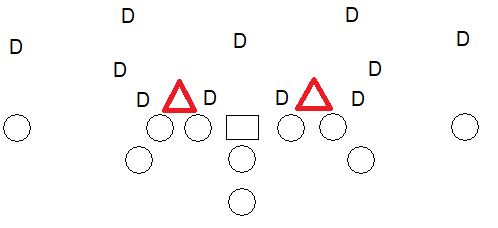
There is not a linebacker at the top of the triangle, and that is because a 4×3 is a 7 man front instead of an 8 man front. There is more of an overlapping linebackers scheme in a 4×3 as the linebackers flow to protect gaps. But there is still a linebacker to the inside of a blocker’s gap so the geometry should be similar.
So let’s get to our plays now and see if the interior blocking looks the same for all three of our plays Midline, Inside Veer and Outside Veer.
Here is the blocking with three players on the line of scrimmage running an option play to the right where the D on the right is the dive key…
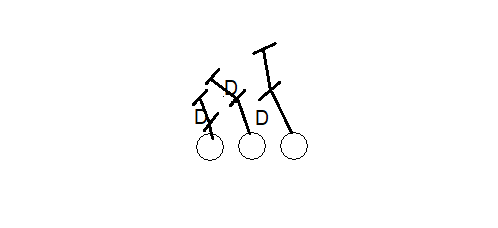
Here is the blocking with two players on the line of scrimmage and a running back running an option play to the right where the D on the right is the dive key…
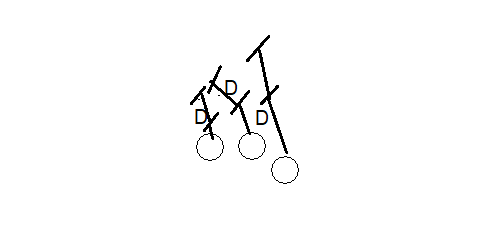
Now let’s take each of our plays and see if the blocking looks the same at the point of attack.
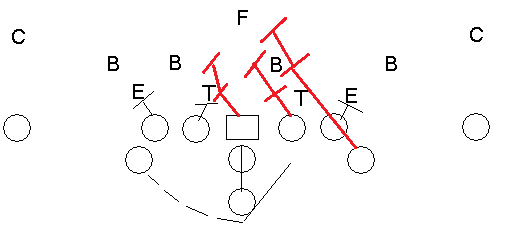
This is Midline against the 4×4 defense attacking the A gap bubble on the right. The lines in red are meant to match the two diagrams above to show the same pattern.
Now let’s go one gap out and run Inside Veer to a bubble in B gap on the right.
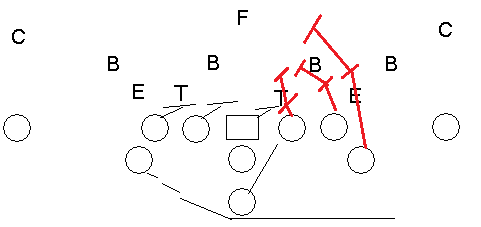
Now let’s finish off the comparison of these three plays by showing Outside Veer.
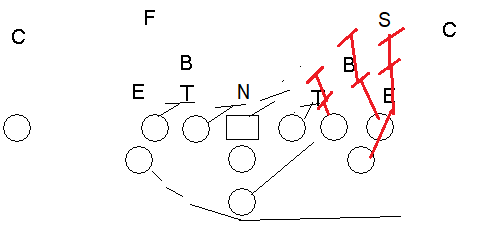
With Outside Veer we want to attack the bubble in C gap on the right. The blocking at the point of attack looks exactly the same as Midline and Inside Veer. In this case, the DE is the dive key and the cornerback is the pitch key. If that playside LB is scraping too hard every time we could run some zone dive at him to slow him down.
Where do we find bubbles against a defense that lines head up on the offensive lineman like a 3×4 that plays 4s with the defensive tackles? It looks like this…
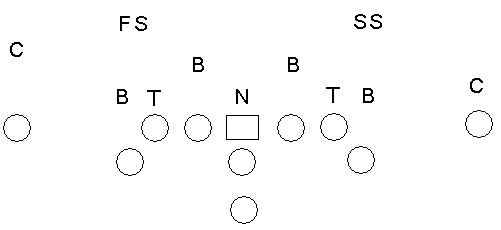
Many times these defenses are going to slant or they are going to read your lineman. If they slant, then hopefully you can find a tendency and call a play that will cause a bubble to be formed that you can attack. Here is a an example in a 3×4 where the slanting to the offense’s right causes a nice A gap bubble on the left for running Midline left.
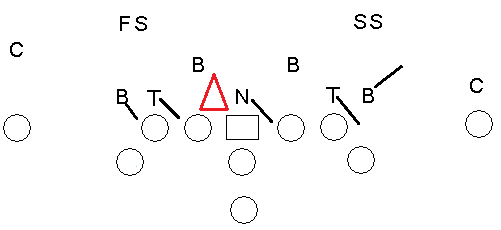
Finally, although I know this is a stretch and is not in the title of the blog post, can we make this concept of a similar blocking scheme even extend to the Quarterback Double-Option play that we are seeing many of the Flexbone teams run? Basically vs a 3×4 there are five defenders between the tackles, so let’s block them down and run outside!

We are attacking the bubble that exists in the D gap here. The corner is the read man. This is double option and not a triple option as only the quarterback and pitch back could get the ball. It does not look quite the same to me, but it is attacking the best bubble with how this defense has aligned to this offensive formation in my opinion.
So in the end, should these plays really be called…
- Midline = A Veer
- Inside Veer = B Veer
- Outside Veer = C Veer
- Quarterback Double Option = D Veer
I don’t see any coach calling these A/B/C/D Veer anytime soon! 🙂 But I do think of them as very close family members! Would you agree?
Please follow me on Twitter so you can get my latest blog posts!
Upside is a free app that gets you cash back on gas! I drive a lot. It saves me money on each fill-up AND it shows me the best local gas prices. Use promo code TERRY283468 to get an extra 15¢/gal bonus on your first purchase. https://upside.app.link/TERRY283468